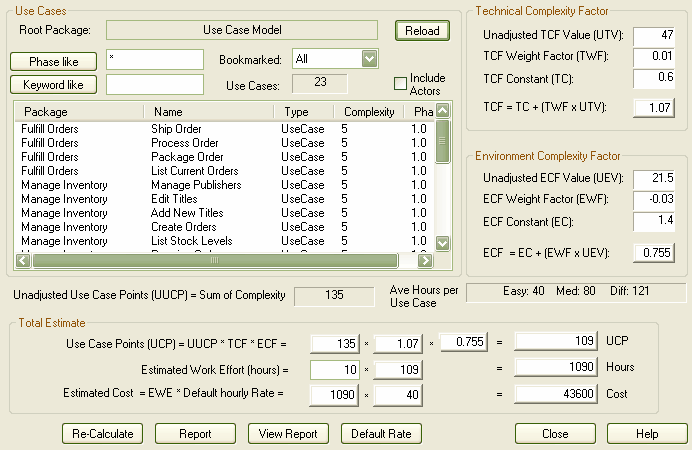Note: This technique is of value only once you have developed a couple of known projects to use as a baseline. Please DO NOT use the provided 'guesstimates' as a real world measure until you have some real world base lines to measure against.
Enterprise Architect uses a simple estimation technique based on the number of Use Cases to be built, the difficulty level of those Use Cases, some project environment factors and some build parameters. Once the parameters are set up and the Use Cases defined, open the Use Case Metrics dialog by:
| · | Navigating to the package of interest and selecting the Project | Use Case Metrics menu option, or |
| · | Right-clicking on the package of interest in the Project Browser window and selecting the Documentation | Package Metrics menu option. |
Field/Button/Panel |
Description |
Root Package |
The root package in the hierarchy. All Use Cases under here could potentially be included in the report. |
Reload |
Re-run the search, usually after you change the filter criteria. |
Phase like |
Include Use Cases with a phase that matches the wildcard value in the field (use * to match any characters, for example 1.* for 1.1 and 1.2). |
Keyword like |
Include Use Cases with a keyword that matches the wildcard value in the field (use * to match any characters). |
Use Cases |
Total count of Use Cases in estimate. |
Technical Complexity Factor |
This panel lists parameters that describe the degree of technical complexity of the project. While the unadjusted TCF value comes from theTechnical Complexity Factor tab of the Metrics and Estimation Types dialog, the other values compose the Use Case Points Method formula. Modify these fields with caution. The final project estimate is directly proportional to the TCF. |
Environment Complexity Factor |
This panel lists parameters that calculate the degree of environmental complexity of the project, from factors such as programmer motivation or experience. The listed parameters compose the formula calculating the ECF, defined by the Use Case Points Method; the only parameter affected by the project is the unadjusted ECF value, derived from the Environment Complexity Factors tab of the Metrics and Estimation Types dialog. The final project estimate is directly proportional to the ECF. |
Unadjusted Use Case Points (UUCP) |
This equals the sum of the Use Case complexity numbers. |
Ave Hours per Use Case |
Averages the number of hours assigned to easy, medium and difficult Use Cases; for information purposes only. |
Total Estimate |
This panel provides a detailed breakdown of the final figure. Note that you must tailor the hours per Use Case point figure to the level that matches your type of project and capability based on known previous project outcomes. |
Default Rate |
Set the default hours fed into the final calculation. |
Re-Calculate |
Re-run the estimate, usually after you change the hours or Use Case point number. |
Report |
Produce a rich text formatted report from the current estimate. |



